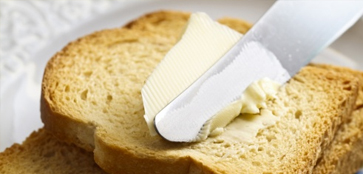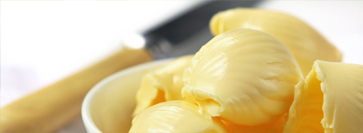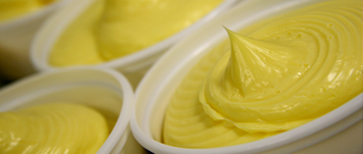Margarine
Margarine

It is said that we live in the age of "fake food", a brave new world where modern food scientists have mastered the art of crafting new foods that masquerade as others that are most familiar. While we may be fascinated with the cutting edge technology of genetic engineering that is used to imbue certain plants and animals with specific characteristics - and political controversy - a host of other "imitation" foods made by more conventional means have become quite commonplace. Indeed, some have become so ubiquitous that we scarcely give them a second thought - imitation ice cream (from soybeans), imitation shrimp (from surimi, a fish paste), and even imitation bacon bits (from texturized vegetable protein) all come readily to mind. Such innovations have been a boon to the Kosher industry. Many erstwhile prohibited foods - from pork to shellfish - may now appear on the Kosher menu, albeit with the aid of some creative food technologists. But while one may assume that such sleight-of-hand is but of recent vintage, it is interesting to note that such innovations have been around for hundreds of years. For example, butter has been known since the times of Avrohom Avinu, but today we frequently use an alternative - margarine. The history - and the Kashrus issues - relating to margarine are indeed quite illuminating.
The story of margarine begins in 1869, during the reign of Napoleon III. The price for butter had increased dramatically, and the Emperor offered a prize to anyone who could develop a suitable alternative to allow the peasants (and the army) to enjoy its baguette et buerre (bread with butter) at an economical price. A food chemist named Hippolyte Mège-Mouriéz won the prize by churning processed beef tallow with cream. Believing that the main component of the solid fat he used was margaric acid (so named by Eguène Chevreuil in 1813 because the white droplets of this fat reminded him of pearls - margarite in Greek), Hippolyte named his new creation margarine. And since the source of the fat was tallow, he combined the word oleo (from the Latin word for beef fat) and margarine, and thus was born oleo-margarine, the "modern" alternative to butter.

Since normal margarine must remain solid at room temperature, the type of fat used in its production must be "hard". Fats are a class of chemicals that generally contain three fatty acids attached to glycerol molecule, and a fatty acid is basically a chain of carbon atoms with hydrogen atoms attached to them at various points. The hardness of fats is determined by the degree of hydrogenation, that is, the number of hydrogen atoms attached to each carbon atom along a chain of carbon atoms. When the maximum number of hydrogen atoms is attached to each available site on the carbon chain, the fat is said to be saturated. Saturated fatty acids are long straight molecules that line up beside each other easily, and therefore pack together easily to form fats that are solid at room temperature. Fats that are missing two hydrogen atoms, one each from two adjacent carbon atoms - are called monounsaturated, and those missing four or more hydrogen atoms are called polyunsaturated fats. The molecules of unsaturated fats are too irregular in shape to line up easily and thus tend to remain liquid at room temperature. In nature, most vegetable oils are mainly monounsaturated or polyunsaturated, whereas animal fats (lard, tallow, and butter) are mainly saturated. For this reason, virtually all margarine - as well as shortening - were historically made from animal fats, and were never considered Kosher products. In the early 1900's, however, food scientists developed a means of putting back some of the missing hydrogen atoms into polyunsaturated fats. This process, called hydrogenation, involves the use of hydrogen gas and a metal catalyst, and has successfully allowed the hardening of otherwise liquid vegetable oils. We can now use partially hydrogenated vegetable oil as shortening and as the raw material for the production of margarine, allowing these products to be Kosher. Indeed, in the United States, vegetable fats have become the predominant type of fats used for these purposes. However, in some countries (e.g. Australia), animal fats remain a major source of fat used in shortening and margarine, and fish oil is still used extensively in many places in Europe. Any potential Kosher status of margarine would obviously presume the use of Kosher vegetable fat.
The production of margarine involves the creation of an emulsion of water in oil similar to that in natural butter. Butter is about 80% fat and 15% water, with the balance being salt and milk proteins. Regular margarine contains between 80-90% fat, with the balance being water, flavorings, and milk solids (Pareve margarine, of course, contains no dairy solids, and relies on various chemicals to give it a buttery flavor). The art of making margarine is to find a way of mixing a hard fat with these other components to create a solid spread resembling natural butter. First, a suitable oil blend is prepared, into which fat-soluble ingredients such as emulsifiers, flavors, and Vitamin A (or Beta Carotene) are added. A separate water-base is also prepared that contains water, salt, and dairy solids, if appropriate. The two mixtures are then blended together, and with the aid of the emulsifiers (chemicals that permit oil and water to blend together) a stable emulsion is created. This oil/water emulsion is then cooled in a special device called a surface swept heat exchanger, which allows the product to crystallize into a uniform solid margarine.
Over the past 100 years, the battle between margarine and butter for the loyalty of the consumer has gone through many phases. Although the butter industry had attempted to portray margarine as an "artificial" food, the marketplace eventually accepted margarine as a wholesome alternative to butter. Indeed, health perceptions of recent years had tended to extol the virtues of polyunsaturated vegetable oil and to excoriate animal and butter fats, although the pendulum seems to be changing. It is interesting to note, however, the vagaries of food science that masquerade as scientific fat. The hydrogenation process, in addition to partially saturating the fat, also causes some of these carbon atoms to rearrange themselves on the carbon chain to create "trans" fats, where previously they were only in the more common form of "cis" fats. Recent scientific research suggests that these trans-fats are potentially far more dangerous to health that saturated fats, and there is now a movement away from hydrogenated vegetable oil margarine back to saturated fat butter! From a Kosher perspective, however, the advantage of margarine is that companies have the ability to make a Pareve product. Most margarine produced today, however, contains whey, and is preferred by the general consumer for its richer buttery taste. It is, however, dairy and thus offers no Kosher advantages over butter. Pareve margarine, on the other hand, is much sought after as a replacement for butter in a variety of Pareve foods in cooking, baking, and frying applications, and relies on Kosher Pareve artificial butter flavor to make up for the lack of dairy ingredients. Unfortunately, there are virtually no all-Pareve margarine facilities currently operating, and the Pareve margarine involves special production runs on equipment that has been Kashered. In addition, margarine companies typically recover the oil from improperly packaged product by melting the margarine and recycling it, a process called "rework". Since Pareve margarine may not contain rework from Dairy margarine, this further complicates the production of Pareve margarine. For these reasons, the availability of Pareve margarine is quite limited.
Dairy concerns, however, are not the only issues of concern in the production of margarine. Regular margarine is about 85% fat, and regardless of the source of the fat, it contains as many calories as butter. In an effort to reduce the number of calories in margarine, scientists have created "light" or "diet" margarine. Some versions of these products merely increase the amount of water blended with the oil, and rely on more chemical emulsifiers to maintain the stability of the emulsion. [These products are much more profitable for the manufacturer, of course, since water is much cheaper than oil, and while they may be successfully spread on bread they cannot be used for baking, frying or other processes involvement heat since the oil and water will easily separate.] Such products pose no special Kosher concerns. However, some companies have found that by adding gelatin to the emulsion the amount of water that can be successfully incorporated into the margarine can be further increased, further lowering the calories (and cost). These products are not Kosher since none of these companies is currently using an acceptable Kosher gelatin. This also creates significant Kashrus concerns in the factories where they are made.
One more Halachik point can be noted concerning Mssr. Mouriéz's imitation butter. It seems that margarine was not the first fake dairy product to be dealt with in Halacha. The Rama (Y.D. 83:3) notes that an imitation milk made from almonds was used in the preparation of meat dishes, and he notes that it might be appropriate to leave a few almonds in the almond milk to avoid any questions about the propriety of food being served. Although the Pri Megadim (S.K. 10) notes that this is only a concern where such products are not commonly used, some caterers post a sign on the table indicating that the margarine being served during the meat meal is Pareve. It may be worth noting that the province of Quebec may have had this in mind when it formulated public policy. Historically, the butter industry has been less than pleased with this challenge to its monopoly, and over the years has tried a number of ways to limit the product's appeal. In some provinces and states, the sale of "colored margarine" was made illegal or heavily taxed, lest the unsuspecting public could confuse it with real butter. In most jurisdictions, such laws are now an anachronism, but the province of Quebec can claim credit for retaining this vestige of consumer protection. To this day, it is illegal to color margarine with a color that is ostensibly too close to natural butter, perhaps unwittingly hewing to the Halachik concerns of indicating the true status of the dairy substitute!

In his parting address to Bnei Yisroel, Moshe Rabbeinu recounts the blessings that were bestowed upon them. Of his many allegorical references, the phrase "butter of cattle" (Devarim 32:14) is curious, since the word Bakar - cattle - is generally used in the context of meat and not milk products. While the Tosefos HaRash interprets the phrase as referring to butter, both Rashi and the Ibn Ezra (Ibid.) seem to be bothered by this metaphor, and therefore explain the verse to indeed allude to an abundance of meat. As we have seen, however, the fat of the meat itself has indeed been made into the likeness of butter, and the issues so raised have proven a blessing to our greater understanding of many interesting Halachos.
